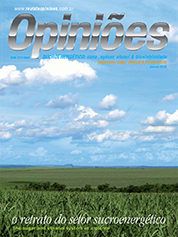José Carlos Grubisich
President of ETH Bioenergia - Grupo Odebrecht
Op-AA-25
Achievements and challenges
The Brazilian bioenergy industry experienced many achievements in 2009. Ethanol consumption grew 20% and for the first time exceeded the use of gasoline in the country. In addition, the heavy investments made by the industry emphasize the importance of this market for the Brazilian economy. Nowadays, sugarcane is present in 22 of the country’s states and employs more than 600,000 people.
It is not by chance that last year this industry represented 1.5% of Gross Domestic Product (GDP). In 2010, this scenario will be no different: the industry’s consolidation is a reality. At the same time that ethanol from sugarcane – a clean, renewable and competitive energy – is on the global agenda of sustainability, electric energy from biomass, co-generated in industrial units from sugarcane bagasse, takes up an important position in the diversification of the Brazilian energy matrix, in what is a new, promising and positive scenario.
The consolidation of dual-fuel technology, built into 90% of new vehicles currently sold in Brazil, also fosters the industry, bringing the outlook of much growth in the market in coming years. At the end of 2010, practically half the Brazilian fleet will allow consumers to decide to fill up their car with ethanol or gasoline. In a few years, the country will have 40 million vehicles and 70% of them will run on either fuel.
Internationally, ethanol attracted attention in a positive manner. Countries that until then used only oil derivative products started seeking clean and renewable sources due to their environmental advantages, in particular with respect to CO2 emissions. An example hereof is the acknowl-edgement by the Environmental Protection Agency (EPA) of the United States that sugarcane ethanol is an advanced fuel.
In addition, one should consider the approval, by the Air Quality Council of the State of California, of the Low Carbon Fuel Standard (LCFS), making it mandatory to reduce CO2 and other greenhouse gas emissions in that state, by 2020. These measures by the U.S. government are very important and are expected to be beneficial for the entry of Brazilian ethanol into the country.
Japan also sees sugarcane ethanol as a solution to reduce CO2 emissions and its dependence on fossil fuel. The local government is working on a project to increase by up to 10% the mixture of ethanol in gasoline by 2020, which will create a potential market of 6 billion liters for the Brazilian product. These positive initiatives, both domestically and internationally, point to an important growth potential for the production and demand of ethanol.
Between 2006 and 2008, Brazil’s domestic consumption alone increased from 12 to 24 billion liters. The trend is to uphold the pace, exceeding 50 billion liters per year by the end of 2015. Thinking in terms of the demand the United States may generate, this will amount to more than 15 billion liters in 2022. Little by little the oil civilization makes room for cleaner, sustainable, and above all, competitive fuel.
This potential of ethanol and its perspectives for the future inaugurate a new phase in the industry’s investments, estimated at US$ 50 billion in the next five years. The entry of new players, such as large agricultural trading companies and oil companies, in addition to the emblematic operations that are redefining the industry – such as the association of Cosan with Nova América; of French company Louis Dreyfus with Santelisa Vale, followed by Bunge with Moema, Shell with Cosan, and by the combination of assets by ETH Bioenergia and Brenco – have filled the news pages, not to mention the acquisition by Petrobras of a share in the capital of Açúcar Guarani and São Martinho.
But that is not all. This trend is expected to intensify in coming years, with the consolidation of companies in terms of scale, technology, and large investment capacity, and to reiterate the business’ attractiveness and the market’s strong growth potential for this fuel. Nowadays, Brazil is the most competitive in the production of renewable energy and derivative products and must invest in the research and development of new technologies to consolidate and maintain this position in the medium and long term.
Brazilian producers will have to combine sustainability and competitiveness to reach the high efficiency needed to continue to lead in the global production of ethanol. Apart from this development required by the domestic and international markets, Brazil needs to get structured to transport ethanol to the large consumer centers and to facilitate its export.
The plan to build a pipeline that will link the ethanol producing region in the Midwest to the port of Santos is currently the most competitive logistic alternative. Investments in the project are estimated at R$ 2 billion and the benefits are impressive, including the reduction in transportation costs of fuel from the new production frontiers to consumer markets, the decrease in diesel consumption and the subsequent reduction in CO2 emissions.
Important achievements were attained in recent years, particularly in 2009 and 2010. However, as we saw, the industry’s growth, domestically and internationally, still depends on much work and significant investments. The time has come to combine efforts so that Brazil may benefit the most from this opportunity.




